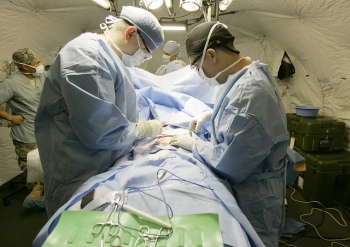Nicolas Andry - The Father Of Modern Orthopedic Surgery

Nicolas Andry is usually considered the father of modern orthopedic surgery, since he did coin the term “orthopaedia.” He even wrote a book about it in 1741, called Orthopaedia, or the Art of Preventing and Correcting Deformities in Children. He got the name from the Greek orthos, meaning “straight,” and pais, meaning “child.” Andry also came up with a symbol: a crooked sapling tied to a stake to help it grow straight. This “Tree of Andry,” came to represent orthopedic surgery across the world. Andry’s thesis was that childhood deformities were the origin of adult deformities, which seems kind of a no brainer.Of course, we’re talking about a time when bloodletting was considered an effective treatment for just about everything, so it’s not that hard to see that this was a revolutionary idea.
During his time, Andry was a controversial figure. Born of poor merchant stock in gay old Paris, he originally studied theology before shifting to medicine. This is when the controversy began. Beginning with his time as a student, his thesis was regarding the psychological states of the doctor and patient in how effective treatment would be. The idea was that a happy doctor and an obedient patient led to success, which isn’t actually that far-fetched. Further controversy created problems for Andry during his ensuing professorship; he had the unfortunate habit of trying to keep barbers from acting like doctors and wouldn’t let them operate without an actual doctor present. (It’s important to remember that barbers were often a go-to for the sick, since they were less expensive and could easily bleed patients with that handy razor.) Though this behavior of Andry’s might seem acceptable to us today, it was frowned upon at the time. And Andry didn’t reserve his irascible nature for barbers; he also held his fellow faculty members to extremely high standards, which eventually led to Andry’s forced resignation.
Andry wrote quite a bit about philosophy and medicine. His first book was on the nature of parasites, which made quite a sensation, though not necessarily in the way he intended. Andry became something of a figure of mockery, earning a mention even from Voltaire. Looking at his observations today, some of what Andry wrote about in this book was a bit absurd, but it was one of the first attempts at a real study of parasitism. But his real breakthrough was his book on childhood deformities, written at the age of eighty after a lifetime of observation and work. In his book, Andry discuses treatments and cures for spinal deformities, such as posture and exercise. Though it was a book on treatment, Andry’s approach was only surgical when absolutely necessary. He even advocated treating crooked limbs by staking the limb to an iron plate as though it were a tree (like the famous symbol). Despite the controversy during Andry’s life, his practical advice and symbology have remained powerful and effective which has ensured his place in history.
